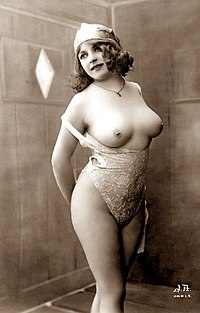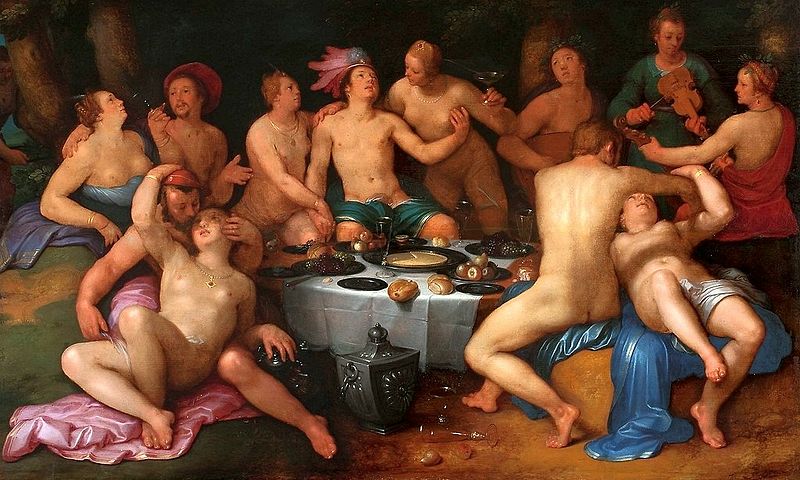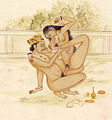Portal:Erotica and pornography
Introduction

Pornography (colloquially known as porn or porno) has been defined as sexual subject material "such as a picture, video, or text" that is intended for sexual arousal. Made for the consumption by adults, pornography depictions have evolved from cave paintings, some forty millennia ago, to virtual reality presentations. A general distinction of adult content is made classifying it as pornography or erotica.
The oldest artifacts considered pornographic were discovered in Germany in 2008 CE and are dated to be at least 35,000 years old. Throughout the history of erotic depictions various people made attempts to suppress them under obscenity laws, censor, or make them illegal. Such grounds and even the definition of pornography have differed in various historical, cultural, and national contexts. The Indian Sanskrit text Kama Sutra (3rd century CE) contained prose, poetry, and illustrations regarding sexual behavior, and the book was celebrated; while the British English text Fanny Hill (1748), considered "the first original English prose pornography," has been one of the most prosecuted and banned books. In the late 19th century, a film by Thomas Edison that depicted a kiss was denounced as obscene in the United States, whereas Eugène Pirou's 1896 film Bedtime for the Bride was received very favorably in France. Starting from the mid-twentieth century on, societal attitudes towards sexuality became more lenient in the Western world where legal definitions of obscenity were made limited. In 1969, Blue Movie became the first film to depict unsimulated sex that received a wide theatrical release in the United States. This was followed by the "Golden Age of Porn" (1969–1984). The introduction of home video and the World Wide Web in the late 20th century led to global growth in the pornography business. Beginning in the 21st century, greater access to the Internet and affordable smartphones made pornography more mainstream. (Full article...)
Erotica is literature or art that deals substantively with subject matter that is erotic, sexually stimulating or sexually arousing. Some critics regard pornography as a type of erotica, but many consider it to be different. Erotic art may use any artistic form to depict erotic content, including painting, sculpture, drama, film or music. Erotic literature and erotic photography have become genres in their own right. Erotica also exists in a number of subgenres including gay, lesbian, women's, bondage, monster and tentacle erotica.
The term erotica is derived from the feminine form of the ancient Greek adjective: ἐρωτικός (erōtikós), from ἔρως (érōs)—words used to indicate lust, and sexual love. (Full article...)
Selected article
Fucking Machines (also known as fuckingmachines.com and fuckingmachines) is a pornographic website founded in 2000 that features video and photographs of women engaged in autoerotic sexual stimulation with penetrative sex-machines and sex toys. Based in San Francisco, California, the site is operated by Kink.com. Web entrepreneur Peter Acworth launched Fucking Machines on September 25, 2000, as his company's second website after Kink.com. Devices shown on the site were created with the intent to bring women authentic orgasms. Performers were instructed to allow themselves to be recorded experiencing pleasure.
After the site applied in 2005 to trademark the phrase "fuckingmachines", the United States Patent and Trademark Office (USPTO) denied the application and ruled that the mark was obscene. Free speech lawyer Marc Randazza represented the site and appealed the decision. Orlando Weekly called his legal brief "one of the most entertaining legal documents you're likely to come across." The appeal was denied in April 2008 and the case was terminated. Randazza's argument in the case became known as The Fuck Brief.
The website has been the subject of attention from journalists and academics studying sexuality. Writer Regina Lynn highlighted the site's emphasis on communication, and Annalee Newitz of AlterNet classed it as part of Porn 2.0. Violet Blue wrote in The Adventurous Couple's Guide to Sex Toys that it helped popularize the idea of machines aiding in sex acts. The 2008 edition of The Oxford Encyclopedia of Women in World History described the aesthetic of the devices as disturbing. Jessica Roy wrote for The New York Observer that Fucking Machines' examples of orgasms were a form of transhumanism. Sarah Schaschek devoted a chapter to the phenomenon in Screening the Dark Side of Love: From Euro-Horror to American Cinema, titled "Fucking Machines: High-Tech Bodies in Pornography". She observed, "Strictly speaking, the women in these videos are both the controllers and the controlled." (Full article...)Selected work of erotic literature
Slideshow of selected contemporary images
Slideshow of selected historical images
Did you know (auto-generated) -

- ... that Jan Kochanowski's Fraszki is a 16th-century collection of almost 300 poems, ranging from anecdotes and epitaphs to obscenities and erotica?
- ... that John Wayne Bobbitt Uncut was the bestselling pornographic film of 1994 and had the most rentals that year in the United States?
- ... that Nickelodeon storyboard artists created a book with hundreds of pornographic drawings of SpongeBob SquarePants characters?
- ... that Claudia Riner was falsely accused of distributing lesbian erotica in the Kentucky House of Representatives?
- ... that later pressings of the soundtrack of the soft porn film The Stud replaced Manfred Mann's Earth Band's "Davy's on the Road Again" after a journalist blabbed its presence to the band's keyboardist?
- ... that Money Shot: The Pornhub Story was described by multiple reviewers as unsalacious?
- ... that the 1980s were the "age of hole-discovery" in yaoi erotica?
- ... that Aroha Bridge changed its name from Hook Ups because fans searching for the show often found pornography instead?
Topics
Categories
Related portals
Associated WikiProjects
 |
 |
| Sexology and sexuality | Pornography |
Associated Wikimedia
The following Wikimedia Foundation sister projects provide more on this subject:
-
Commons
Free media repository -
Wikibooks
Free textbooks and manuals -
Wikidata
Free knowledge base -
Wikinews
Free-content news -
Wikiquote
Collection of quotations -
Wikisource
Free-content library -
Wikiversity
Free learning tools -
Wiktionary
Dictionary and thesaurus





































































![Image 17Indian Princess, by Richard Borrmeister [de] (1888?)](http://upload.wikimedia.org/wikipedia/commons/thumb/0/01/Richard_Borrmeister_Indische_Prinzessin_1888.jpg/102px-Richard_Borrmeister_Indische_Prinzessin_1888.jpg)



































